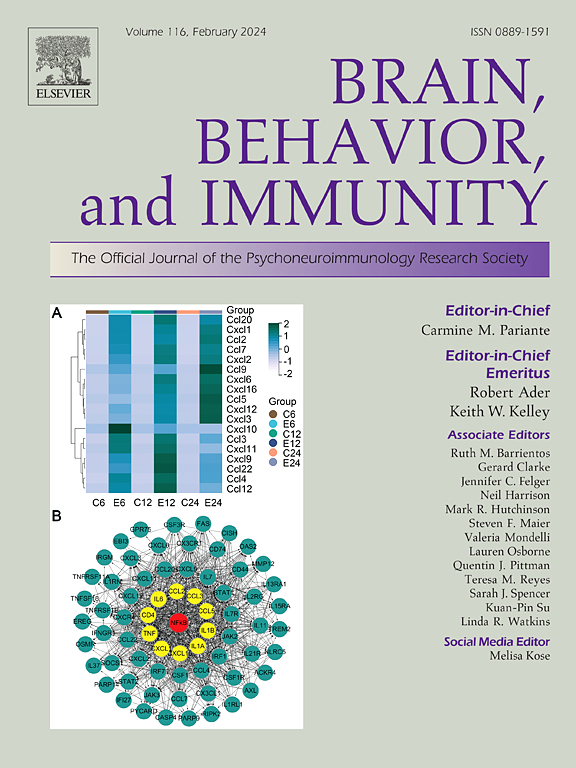Fibroblast-derived IL-33 exacerbates orofacial neuropathic pain via the activation of TRPA1 in trigeminal ganglion neurons
IF 8.8
2区 医学
Q1 IMMUNOLOGY
引用次数: 0
Abstract
Damage to the peripheral nerves of trigeminal ganglion (TG) neurons leads to intractable orofacial neuropathic pain through the induction of neuroinflammation. However, the details of this process are not yet fully understood. Here, we found that fibroblast-derived interleukin (IL)-33 was required for the development of mechanical allodynia in whisker pad skin following infraorbital nerve injury (IONI). The amount of IL-33 in the TG increased after IONI when the mice exhibited mechanical allodynia. Neutralization of IL-33 in the TG inhibited the development of IONI-induced mechanical allodynia. Conversely, intra-TG administration of recombinant human IL-33 (rhIL-33) elicited mechanical allodynia in naïve mice. IL-33 and its receptor were exclusively expressed in fibroblasts and neurons, respectively, in the TG. Fibroblast ablation caused the loss of IL-33 in the TG and delayed the development of mechanical allodynia after IONI. rhIL-33 elicited an increase in intracellular Ca2+ concentration and subsequent enhancement of Ca2+ influx via transient receptor potential ankyrin 1 (TRPA1) in primary cultured TG neurons. Additionally, rhIL-33 facilitated membrane translocation of TRPA1 in the TG. Mechanical allodynia caused by intra-TG administration of rhIL-33 was significantly inhibited by pharmacological blockade or gene silencing of TRPA1 in the TG. Inhibition of protein kinase A abrogated TRPA1 membrane translocation and delayed mechanical allodynia after IONI. Substance P stimulation caused upregulation of IL-33 expression in primary cultured fibroblasts. Preemptive administration of a neurokinin-1 receptor antagonist in the TG attenuated mechanical allodynia and IL-33 expression following IONI. Taken together, these results indicate that fibroblast-derived IL-33 exacerbates TG neuronal excitability via suppression of tumorigenicity 2 (ST2)-TRPA1 signaling, ultimately leading to orofacial neuropathic pain.
成纤维细胞衍生的IL-33通过激活三叉神经节神经元中的TRPA1加剧口面部神经性疼痛
三叉神经节(TG)神经元的外周神经受损会诱发神经炎症,从而导致难治性口面部神经病理性疼痛。然而,这一过程的细节尚未完全清楚。在这里,我们发现成纤维细胞衍生的白细胞介素(IL)-33是眶下神经损伤(IONI)后须垫皮肤发生机械异感所必需的。眶下神经损伤后,当小鼠表现出机械异感时,TG中的IL-33含量会增加。中和TG中的IL-33可抑制IONI诱发的机械异感的发生。相反,在TG内注射重组人IL-33(rhIL-33)可引起天真小鼠机械性异感。IL-33 及其受体分别只在 TG 中的成纤维细胞和神经元中表达。在原代培养的TG神经元中,rhIL-33引起细胞内Ca2+浓度增加,随后通过瞬时受体电位ankyrin 1(TRPA1)增强Ca2+流入。此外,rhIL-33 还能促进 TRPA1 在 TG 中的膜转位。通过药物阻断或基因沉默TRPA1可显著抑制TG内注射rhIL-33引起的机械痛觉。抑制蛋白激酶A可减弱TRPA1的膜转位并延迟IONI后的机械性痛觉。物质P刺激会导致原代培养成纤维细胞中IL-33的表达上调。在TG中预先给予神经激肽-1受体拮抗剂可减轻IONI后的机械异感和IL-33表达。综上所述,这些结果表明,成纤维细胞衍生的IL-33通过抑制肿瘤生成2(ST2)-TRPA1信号传导,加剧了TG神经元的兴奋性,最终导致口面部神经病理性疼痛。
本文章由计算机程序翻译,如有差异,请以英文原文为准。
求助全文
约1分钟内获得全文
求助全文
来源期刊
CiteScore
29.60
自引率
2.00%
发文量
290
审稿时长
28 days
期刊介绍:
Established in 1987, Brain, Behavior, and Immunity proudly serves as the official journal of the Psychoneuroimmunology Research Society (PNIRS). This pioneering journal is dedicated to publishing peer-reviewed basic, experimental, and clinical studies that explore the intricate interactions among behavioral, neural, endocrine, and immune systems in both humans and animals.
As an international and interdisciplinary platform, Brain, Behavior, and Immunity focuses on original research spanning neuroscience, immunology, integrative physiology, behavioral biology, psychiatry, psychology, and clinical medicine. The journal is inclusive of research conducted at various levels, including molecular, cellular, social, and whole organism perspectives. With a commitment to efficiency, the journal facilitates online submission and review, ensuring timely publication of experimental results. Manuscripts typically undergo peer review and are returned to authors within 30 days of submission. It's worth noting that Brain, Behavior, and Immunity, published eight times a year, does not impose submission fees or page charges, fostering an open and accessible platform for scientific discourse.

 求助内容:
求助内容: 应助结果提醒方式:
应助结果提醒方式:


